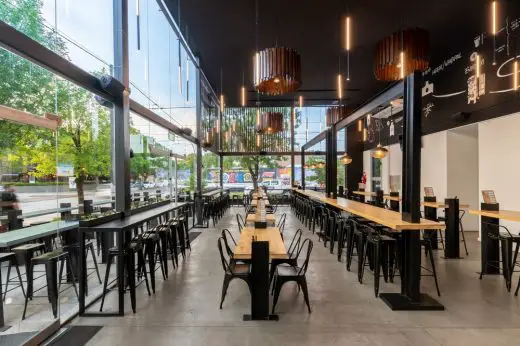How early America defined architecture in 2 different time zones, US real estate design trends, American buildings guide
How Early America Defined Architecture Guide
19 July 2022
Architecture in the United States varies across time and regions. The country was initially built through mainly European external means, prior to its infamous industrial revolution. This architecture is characterized by eclecticism, because it draws its sources mainly from different historical styles of European design, but also from new gigantism, a symbol of the economic power that America has achieved.
How Early America Defined Architecture in 2 Different Time Zones
East vs. West
The oldest examples of architecture in the United States fall in two major locations.
- The first is in the eastern half of the country, where there is ancient evidence of a mound-builder culture where zoomorphic mounds and earth pyramids were created to bury the dead. Situated in the Mississippi Valley, the city of Cahokia was at its architectural peak in the 13th century. This site, a UNESCO World Heritage Site, had about 120 burial mounds and temples.
- The Southwest is the second region, and home to Native American civilizations that disappeared soon after European colonization. The most famous archaeological sites are from the Anasazi culture, such as Mesa Verde (Colorado) and Chaco Canyon (New Mexico).
Inhabited since 1150, Acoma is the oldest pueblo in the United States. It is a village built on a plateau and consists of flat-roofed adobe houses, made from sun-dried raw earth brick. These homes are held together by exposed wooden beams. Their cubic shape and interweaving architecture give the villages that special aspect that would later be taken over by Americans (pueblo style).
Spanish Influences
The Spanish exploration of the American Southwest began in the 1840s. Conquistador Francisco Vásquez de Coronado traveled this arid region in search of the mythical gold cities of the Pueblo Indians. The Spaniards eventually conquered Native American villages and made Santa Fe the administrative capital of the region in 1609. The Governor’s Palace was built by mixing Indian (adobe) and Spanish (iron gates) influences. The San Miguel de Santa Fe chapel dates from 1610 and uses the adobe technique to give this religious building a striking massiveness and austerity.
Spanish domination also extended to Florida intermittently from 1559 to 1821. Here, for example, the style shell had some success in Pensacola. Houses were decorated with wrought-iron balconies, a trend infamously found in the French Quarter of New Orleans, LA.
The British Style
The colonial or “Victorian” architecture of the 13 American colonies is marked by the English model. But climatic and religious differences introduce American elements. In New England, the Pastor Capen home in Massachusetts is covered with shingles and the frame is made of wood, two distinctive features of America. Puritanism imposed simple and sober places of worship and sober, far from any ostentatious decoration.
In the 18th century Georgian and Palladian architecture developed from the city of Williamsburg, Virginia. Built in 1706-1720, the Governor’s Palace is preceded by a large entrance gable and topped with a lantern placed on a balustrade platform. The architectural style supports the principle of symmetry. It combines the materials found in New England: red brick, white painted wood, and blue slate for a gable roof.
This style was inspired by Christopher Wren’s English Baroque architecture and served as a model for the homes of planters and wealthy merchants on the Atlantic coast. The principles of construction are axial symmetry, the importance of the central building, and attention to proportions. This type of building became dangerous for construction workers of the time, who suffered egregious injuries. Unfortunately, there was no compensation for architectural liability, as there is today.
The Greek Comeback
The Ancient Greek Revival style, which fits in with the current neo-classical, became an initiative for architects working in the United States in the first half of the nineteenth century. The young nation, freed from British tutelage was convinced that it was the new Athens, a center of democracy. The constitution gave birth to new institutions that required buildings and imposed rules on national sovereignty and the separation of powers. Civil and religious architecture reflected this vision and took the buildings of the Acropolis as its model.
Prominent architects of the time received orders to build banks and churches in major cities (Philadelphia, Baltimore, and Washington). One of the later examples of this trend is the Ohio capital city of Columbus, designed by Henry Walters and completed in 1861. The subdued facade, continuous cornice and the absence of a dome give the building an impression of austerity and grandeur. It has a symmetrical plan and houses the Supreme Court and a library.
Protection
Apart from the Civil War, the United States hasn’t seen combat on its land that puts its historical architecture at risk. However, American geography and topography poses a serious natural threat to its heritage. The California earthquakes and the cyclones around the Gulf of Mexico are particularly devastating.
To protect historic buildings, the federal government established several institutions in the early twentieth century, when US national monuments were created to protect natural sites, but also architectural designs (Indian villages, colonial-period forts, Spanish missions, etc.). Since 1935, the National Park Service has been responsible for listing buildings, monuments, or areas of historic interest in the United States.
Comments on this How Early America Defined Architecture in 2 Different Time Zones article are welcome.
American Architecture Designs
American Architectural Designs – selection:
Design: Steven Holl Architects
Nancy and Rich Kinder Building Houston
Design Architect: Schmidt Hammer Lassen Architects
Commonwealth Pier Boston
Building Articles
Architects: VS Arquitectura

photo : Architect Gonzalo Viramonte
Bocatoma Taproom in Cerro de las Rosas, Córdoba
Comments / photos for the How Early America Defined Architecture in 2 Different Time Zones page welcome






